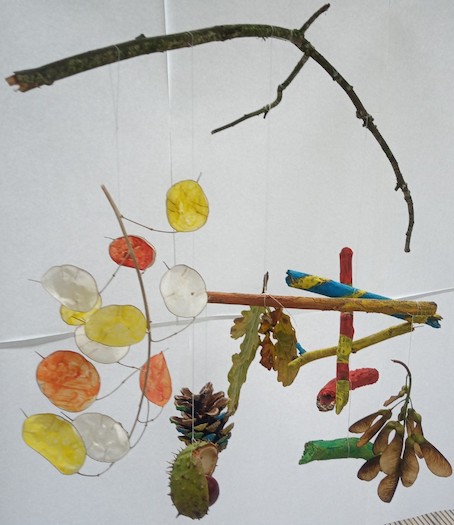
Mobiles provide a fun way of displaying found natural objects, and also an opportunity for artwork. Find a stick with a bit of character and then hunt around for interesting items to hang from it. Cones, seed pods, berries, feathers and leaves will all work. If the mobile is to last then it is best to avoid items which will dry out quickly, like flowers. However, both leaves and flowers will last much better if they are pressed first. A simple mobile, like that shown on the left, is easy to construct. Cotton will do very well unless the whole thing gets too heavy. It's best to tie the down-strings to the stick first - this can be a bit fiddly, so youngsters may need some help - and then to attach them to the items. Once this is done, you will find that there is always a point on the stick where it balances (physicists call this the "centre of mass"), so you tie the suspension thread at this point. This could then be fixed to the ceiling in a child's room, so they have their very own home made mobile.
Autumn is an especially good time to find natural objects for a mobile. However, there are other possibilities. A trip to the beach may provide plenty of items for a "sea mobile". Shells may require a small hole drilling in them so that they can be suspended, small pieces of sea-worn wood, colourful stones or pieces of sea glass will look attractive. Mobiles can also celebrate the seasons, and specific festivals. For example an egg mobile for Easter, and holly, ivy, mistletoe and stars for Christmas.
Children will enjoy making mobiles more colourful using paints, or by adding coloured beads to the strings. They can even make their own beads from clay and paint them, as described here.
More ambitious mobiles can include more than one layer. In this case it is best to start at the bottom and work your way up to the top layer. Further ideas and guides from around the world for making different kinds of mobiles can be found here, here and here.
